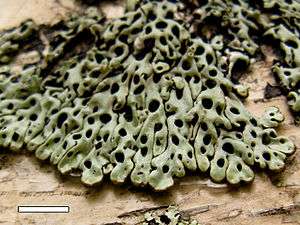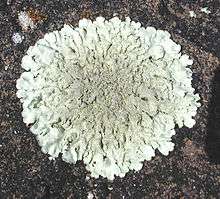Parmeliaceae
| Parmeliaceae | |
|---|---|
 | |
| Parmelia cunninghammii, photographed in New Zealand. Scale bar = 1 cm. | |
| Scientific classification | |
| Kingdom: | Fungi |
| Division: | Ascomycota |
| Class: | Lecanoromycetes |
| Order: | Lecanorales |
| Family: | Parmeliaceae Zenker (1827) |
| Type genus | |
| Parmelia Ach. | |
The Parmeliaceae is a large and diverse family of Lecanoromycetes. With over 2000 species in roughly 87 genera, it is regarded as the largest family of lichen forming fungi.[1][2] The most speciose genera in the family are the well-known groups: Xanthoparmelia (800+ species), Usnea (500+ species), Parmotrema (350+ species), and Hypotrachyna (190+ species).[1][2]
Nearly all members of the family have a symbiotic association with a green alga (most often Trebouxia spp., but Asterochloris spp. are known to associate with some species).[3] The majority of Parmeliaceae species have a foliose, fruticose, or subfruticose growth form. The morphological diversity and complexity exhibited by this group is enormous, and many specimens are exceedingly difficult to identify down to the species level.
The family has a cosmopolitan distribution, and can be found in a wide range of habitats and climatic regions.[4] This includes everywhere from roadside pavement to alpine rocks, from tropical rainforest trees to subshrubs in the arctic tundra. Members of the Parmeliaceae can be found in most terrestrial environments.
Taxonomy
Based on several molecular phylogenetic studies, the Parmeliaceae as currently circumscribed has been shown to be a monophyletic group.[5] This circumscription is inclusive of the previously described families Alectoriaceae, Anziaceae, Hypogymniaceae, and Usneaceae, which are all no longer recognised by most lichen systematists. However, despite the family being one of the most thoroughly studied groups of lichens, several relationships within the family still remain unclear. Phylogenetic analysis tentatively supports the existence of six separate clades in the family:[2]
- Alectorioid clade (3 genera)
- Cetrarioid clade (8 genera)
- Hypogymnioid clade (4 genera)
- Letharioid clade (2 genera)
- Parmelioid clade (26 genera)
- Psiloparmelioid clade (2 genera)
However, this still leaves roughly 42 Parmeliaceae genera unplaced.
Characteristics
Thallus
Parmeliaceae thalli are most often foliose, fruticose or subfruticose, but can be umblicate, peltate, caespitose, crustose, or subcrustose. One genus, Nesolechia, is even a lichenicolous fungus. They can be a variety of colours, from whitish to grey, green to yellow, or brown to blackish (or any combination therein). Many genera are lobe forming, and nearly all are heteromerous (which are corticate on both sides). Species are usually rhizinate on the lower surface, occasionally with holdfasts, rhizohyphae, or a hypothallus. Only a few genera have a naked lower surface (for example Usnea, Hypogymnia and Menegazzia). The upper surface has a pored or non-pored epicortex. Medulla is solid, but often loosely woven.[6]
Apothecia
Apothecia are lecanorine, produced along the lamina or margin, and sessile to pedicellate (or less often sunken). Thalline exciple is concolourous with the thallus. Asci are amyloid, and the vast majority of species have eight spores per ascus, though a few species are many-spored, and several Menegazzia species have two spores per ascus.[6]
Spores
Ascospores are simple, hyaline, and often small. Conidia generally arise laterally from the joints of conidiogenous hyphae (Parmelia-type), but arise terminally from these joints in a small number of species (Psora-type). The conidia can have a broad range of shapes: cylindrical to bacilliform, bifusiform, fusiform, sublageniform, unciform, filiform, or curved. Pycnidia are immersed or rarely emergent from the upper cortex, are produced along the lamina or margins, pyriform in shape, and dark-brown to black in colour.[6]
Chemistry
Members of the Parmeliaceae exhibit a diverse chemistry, with several types of lichenan (Xanthoparmelia-type, Cetraria-type, intermediate-type), isolichenan and/or other polysaccharides being known from the cell walls of many species.[6]
Photobiont
The main photobiont genus that associates with Parmeliaceae species is the Chlorophyte Trebouxia. In particular the species Trebouxia jamesii appears to be especially prominent. Some Parmeliaceae genera are also known to associate with Asterochloris,[3] but the frequence of this association is not yet known. In general photobiont diversity within the Parmeliaceae is a little studied subject, and much is left to discover here.
Genera
Image gallery

 Cetraria nivalis from Austria.
Cetraria nivalis from Austria. Parmelia sulcata from Commanster, Belgium.
Parmelia sulcata from Commanster, Belgium. Usnea rubicunda growing on a branch in Mendocino County, California.
Usnea rubicunda growing on a branch in Mendocino County, California. Allocetraria oakesiana growing on bark in Highland County, Virginia.
Allocetraria oakesiana growing on bark in Highland County, Virginia. Alectoria ochroleuca from Carianthia, Austria.
Alectoria ochroleuca from Carianthia, Austria. Everniastrum catawbiense from Steuben, Maine.
Everniastrum catawbiense from Steuben, Maine. Xanthoparmelia cf. lavicola, on basalt in Hawaii.
Xanthoparmelia cf. lavicola, on basalt in Hawaii.
 Letharia vulpina at Mt. Gleason, California.
Letharia vulpina at Mt. Gleason, California.
Notable taxa
Some well known members of the Parmeliaceae are:
- the genus Parmelia
- the genus Usnea (old man's beard)
- Oakmoss (Evernia prunastri)
- Iceland moss (Cetraria islandica)
- Wila (Bryoria fremontii)
References
- 1 2 Bisby, Guy Richard; Ainsworth, G. C.; Kirk, P. M.; Aptroot, André (2001). Ainsworth & Bisby's Dictionary of the fungi / by P. M. Kirk... [et al.]; with the assistance of A. Aptroot... [et al.] Oxon: CAB International. p. 378. ISBN 0-85199-377-X.
- 1 2 3 Crespo, A.; Lumbsch, H. T.; Mattsson, J. E.; Blanco, O.; Divakar, P. K.; Articus, K.; Wiklund, E.; Bawingan, P. A.; Wedin, M. (August 2007). "Testing morphology-based hypotheses of phylogenetic relationships in Parmeliaceae (Ascomycota) using three ribosomal markers and the nuclear RPB1 gene". Molecular Phylogenetics and Evolution. 44 (2): 812–824. doi:10.1016/j.ympev.2006.11.029. PMID 17276700.
- 1 2 Miadlikowska, J. et al. (2006). New insights into classification and evolution of the Lecanoromycetes (Pezizomycotina, Ascomycota) from phylogenetic analyses of three ribosomal RNA- and two protein-coding genes. Mycologia 98: 1088-1103. http://www.mycologia.org/cgi/reprint/98/6/1088.pdf
- ↑ Cannon PF, Kirk PM (2007). Fungal Families of the World. Wallingford: CABI. p. 256. ISBN 0-85199-827-5.
- ↑ Crespo Ana; Blanco, Oscar; Hawksworth, David L (2001). "The potential of mitochondrial DNA for establishing phylogeny and stabilising generic concepts in the parmelioid lichens". Taxon. 50 (3): 807–19. doi:10.2307/1223708. JSTOR 1223708.
- 1 2 3 4 Elix, J.A. (1994). Parmeliaceae. Flora of Australia – Volume 55. http://www.environment.gov.au/biodiversity/abrs/publications/flora-of-australia/vol55.html
External links
- Index Fungorum
- Parmeliaceae at the online Encyclopedia of Life
- Parmeliaceae on Wikispecies.